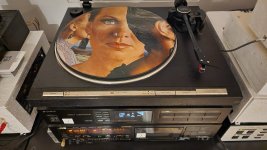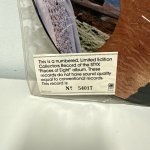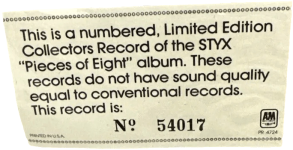The question that I have isn't just about photo LP albums but many of the albums out there. Some will actually claim that they come from virgin vinyl or maybe even a superior mix of elements. So, do different labels have their own secrets? I doubt it. It is just that we take some of this for granted.
Is it more flexible than vinyl?What are they made of? Is it pvc?
I once had a 7 inch promo disk, as thin as a piece of paper.
Hugo
Styx "Pieces of Eight". The regular LP does not sound very good either. 😉
Ed
Ed
Ah yes, thanks. Was thinking of this album for some reason. Gonna give it a spin right now.


Last edited:
Got two normal ones, sound way better.Styx "Pieces of Eight". The regular LP does not sound very good either. 😉
Ed
Attachments
"Vinyl" is PVC, afaik.Is it more flexible than vinyl?
Looking on the internet, I see different formulations. Who knows. Internet is always right. Haha
Black vinyl contains carbon black which is supposed to reduce wear. Picture disks like the above and other colours were certaintly thought to wear faster - though I can't find a definitive answer to confirm this (there's also a theory black simply disguises recycled PVC). Commercial pressings are either PVC (aka vinyl) or occasionally acetate (for test pressings) - acetate wears really fast.
I also read that carbon black might be to reduce static, but untreated black vinyl definitely builds up static efficiently in dry conditions so I don't believe that theory.
I also read that carbon black might be to reduce static, but untreated black vinyl definitely builds up static efficiently in dry conditions so I don't believe that theory.
I just find some recordings sound much better than others, and it has comparatively little to do with the vinyl, or weight of the vinyl it is pressed on.
The new generation of picture discs which appeared in the 1970s were made by creating a five-layer lamination consisting of a core of black vinyl with kiln-dried paper decals on either side and then outer skins of clear vinyl film, manufactured by 3M, on the outsides. They had acceptable but still inferior sound quality.
Information from: https://en.wikipedia.org/wiki/Picture_disc
Information from: https://en.wikipedia.org/wiki/Picture_disc
Totally agree.I just find some recordings sound much better than others, and it has comparatively little to do with the vinyl, or weight of the vinyl it is pressed on.
A couple of examples: Tanita Tikaram "Anvient Heart" & Paul Simon "Hearts and Bones", both on thin, floppy vinyl sound
absolutely amazing.
Black vinyl contains carbon black which is supposed to reduce wear. Picture disks like the above and other colours were certaintly thought to wear faster - though I can't find a definitive answer to confirm this...
Not only does the carbon strengthen the vinyl, but it affects sound quality.
A clear vinyl picture disc can not have a better sound quality compared to the standard black vinyl.
I have seen picture disks in the past (like the 80's) that were played so many times that the picture actually was beginning to wear 😳. I have a few but I don't play them. They are more for decoration.Not only does the carbon strengthen the vinyl, but it affects sound quality.
A clear vinyl picture disc can not have a better sound quality compared to the standard black vinyl.
I have heard about the carbon additive before but assumed it was for color uniformity. Thanks Galu. I wonder what is added for adason's white disc, gypsum or talc maybe.
I have some original Mofi discs. They are black but when held up to the light they are translucent although heavier than other records.
- Home
- Source & Line
- Analogue Source
- Low quality lp?






